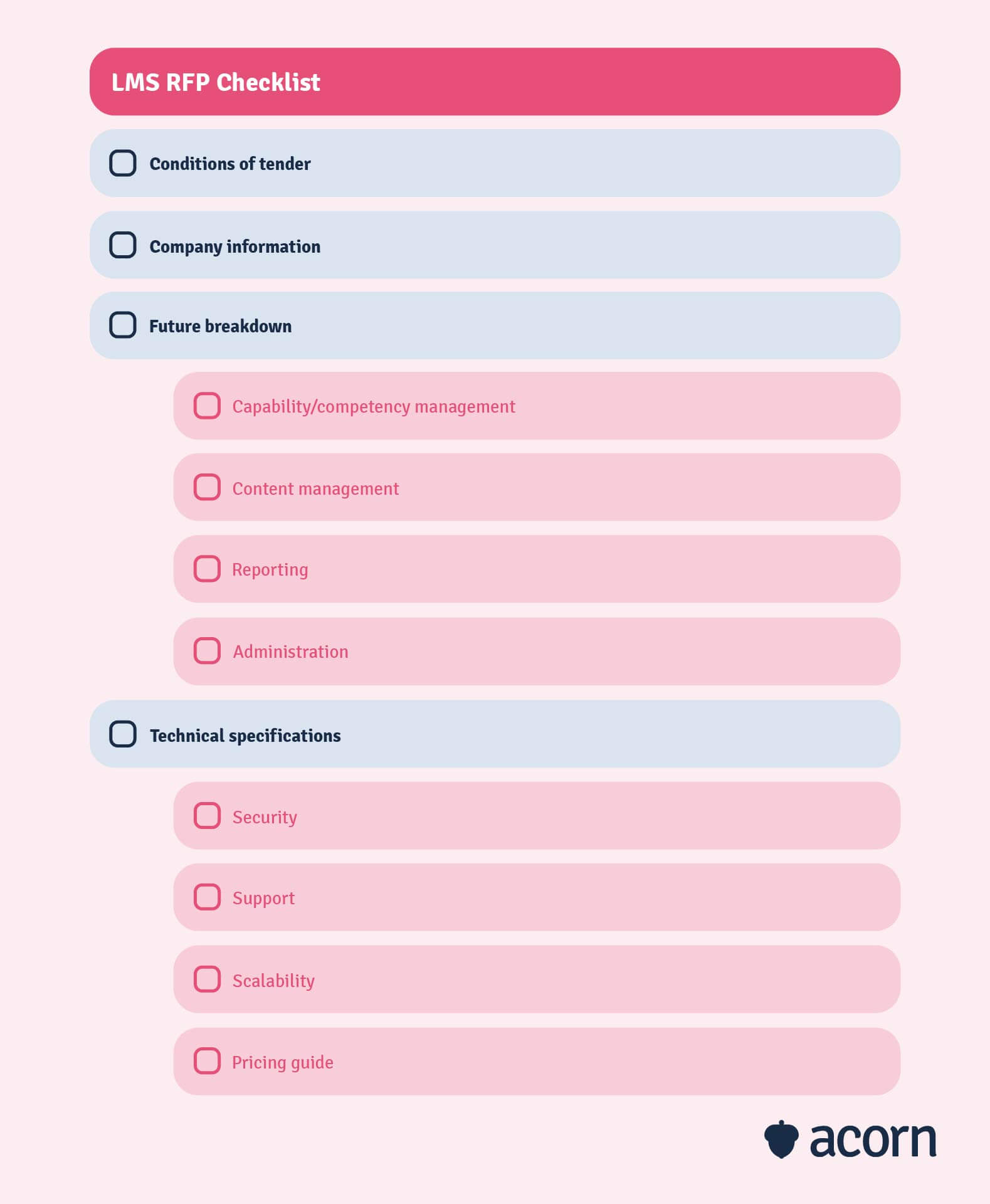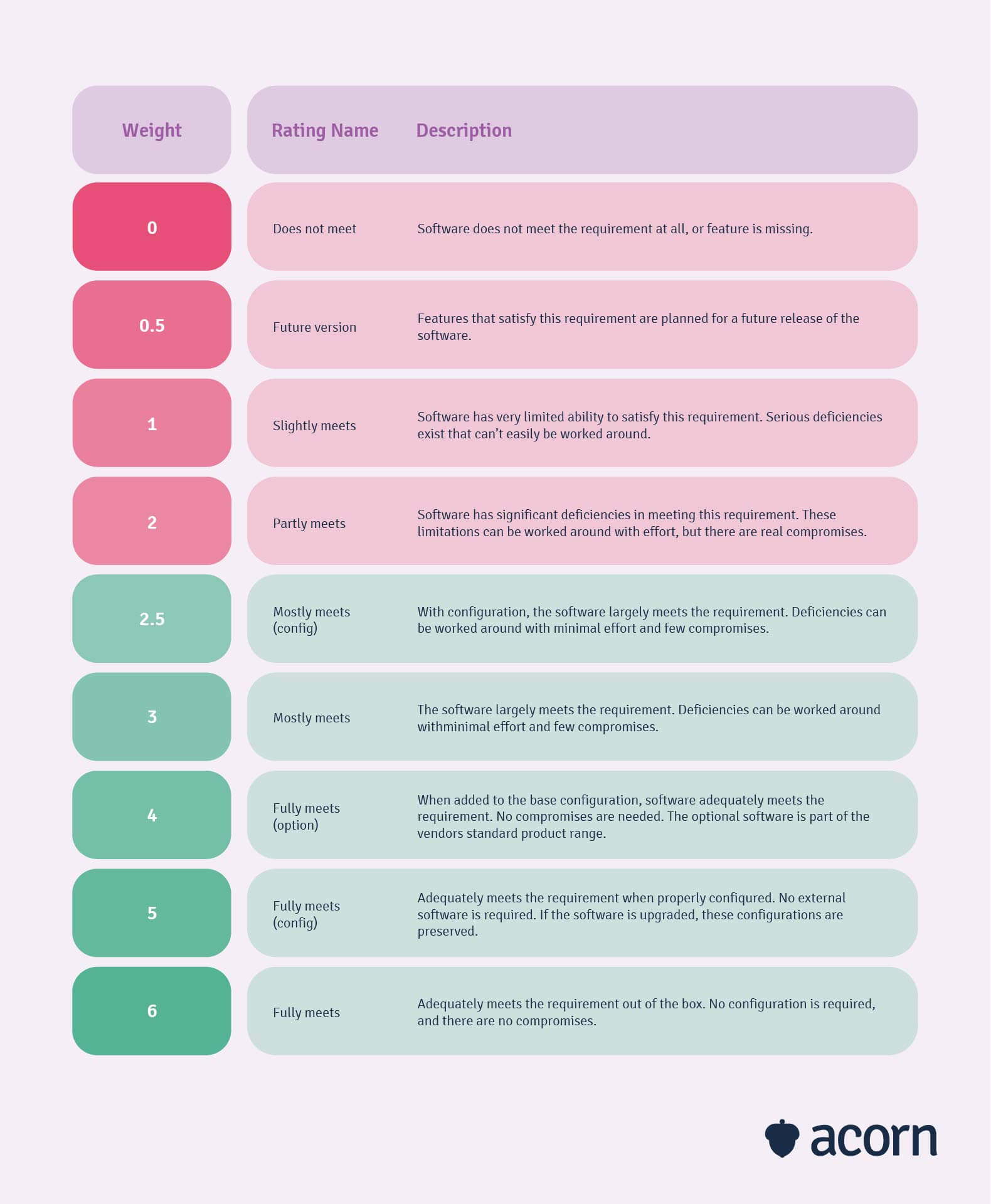Your Comprehensive LMS RFP Template

Vetting vendors is all the more easier with this template and step-by-step guide on how to use it.
There’s a world of difference between not doing an LMS RFP, doing an RFP, and doing an RFP well.
A good request for proposal (RFP) is the difference between fielding dozens of unsuitable LMS suppliers and finding the perfect match for your needs, thereby boosting employee engagement, streamlining your internal processes and increasing your revenue in the process.
We’ve seen hundreds of RFPs in our time, so we’re uniquely qualified to offer an optimized (and unbranded) LMS RFP Template. Download it, and then continue reading to learn how to seamlessly move through the request for proposal process.
The only LMS RFP template you’ll ever need
As an LMS supplier, there are certain things we need to know, some things we want to know, and many things that just aren’t relevant during the qualifying stage. As the penultimate step of your LMS buying process, it’s not the place for knowledge gaps or misunderstandings to crop up. A good RFP assumes the potential supplier knows nothing about you, asks a lot of questions about them, and benefits from the careful eye of one document editor.
We’ve seen good and bad RFPs, the crystal clear and the clear as mud, those that contradict themselves and the ones drowning in information overload—meaning we’re not just boasting when we say ours is the only LMS RFP Template you’re ever going to need. With the knowledge and experience of having completed (and won, if you’ll allow the humble brag) many RFPs, this template will invoke thoughtful and illuminating responses from potential suppliers.
Why a good RFP is game changing
Aside from needlessly complicating an otherwise straightforward process, a bad RFP dilutes brand value for suppliers, sparks administrative delays on your end, and saps money and time from both ends. When the impacts could extend to both you and your potential supplier, are these considerations you have given thought to?
Copying any old RFP template (or worse, blindly fashioning a structure yourself) means you often skip over why you need an RFP in the first place. Without a why, goal or objective, your questions have little meaning and the responses you get even have less, since you have no criteria against which to weigh them. Such an unclear RFP leads to differing supplier interpretations, which in turn gives you varying and potentially incompatible proposals.
With an exhaustive RFP, you’re not searching for LMS suppliers on an ad hoc basis. This would be akin to having an overgrown garden and panic buying the first lawn mower you see, without comparing prices, brands, reviews and product specifications. When you’ve got thousands of dollars, hundreds of potential users, future succession planning and a number of dependent projects on the line, a good RFP template is the difference between success and failure.
What’s in an LMS RFP?
LMS RFPs are primarily divided into two sections: About you and about the supplier. The details are unique to you, but the key points you want to hit won’t be all that dissimilar to other organisations seeking an LMS.
About you
Give a little context about your organisation, your business drivers, and the logistics for LMS implementation. Don’t waffle on about your life story, but do detail your current situation, primary challenges and what your goals are. You’ll want to cover:
- Organisation structure
- Purpose of RFP
- Project goals, for eLearning and business objectives
- Criteria for success
- Input data, such as number of active users
- Technical requirements, including scalability, data migration and security
- Critical deadlines
- Expected deployment schedule.
About the supplier
The supplier’s response shouldn’t read like a waffling love letter, but rather a direct and concise reply to all the items and key points you addressed. It’ll need to include:
- Executive summary, including the key points of their solution
- Supplier history, organisation structure, location, team, clients, experience and point of difference
- References and/or case studies
- Pricing.
Their solution
Suppliers need to be able to give you a personalised but succinct plan that addresses the gaps, issues or goals you have outlined. Ensure you ask them to detail the type of support you’ll receive, included and additional costs, and how they will (or won’t) meet your timeframes (and if not, why this is so and why their system will still benefit you).
LMS RFP Template
The right LMS RFP shows suppliers and stakeholders you are serious, organised and you have a dedicated budget. It also ensures you identify a licensing model, pricing and technical specifications that are right for your goals.
Take our LMS RFP Template. There’s little upfront work you have to do to make a good impression, we’ve done that for you. Using our guide, you can create a crystal clear proposal.
And if I don’t use this template?
The primary purpose of an RFP is to communicate your requirements for a project to suppliers who you believe can possibly provide the right solution. This template is designed to establish a clear joint understanding of these requirements, as they will become the baseline for your LMS project. Perhaps most importantly, it also becomes the baseline for an eventual contract and a crucial historical document, should issues arise.
If you find yourself going down the audit trail without a point of reference, you may be caught out with schedule delays and fees related to additional features or contractual changes. You are the boss in this project, not the supplier—we’ve heard horror stories from clients transitioning from other suppliers who walked all over them and dictated their needs to them.

Communicating with LMS suppliers
At this stage of the LMS selection or qualifying process, you should be courting no less than two but no more than five suppliers. (Yes, it’s really that serious.) Anymore, and you’re wading through unnecessary paperwork and diminishing your ability to distinguish between solutions, and any less, and you’re probably not going to see enough of a difference to compare.
If you want considered responses, you’re looking at a lead time of about four weeks. Remember, as much as you might be looking to get up and running now, a supplier is still working with other clients and conducting their normal business activities. Identify a one or two week window in that time when you’ll be available to answer questions to clarify scope or intentions, so neither party is overwhelmed by questions from the other.

As we previously mentioned, make assumptions when communicating with potential suppliers. There are things they do know and could glean from their own research, but the safest route is to tell them, in your words, about your needs, your processes and the ideals your organisation stands by. Make clear every little detail, from what type of fonts you want used in documents to specific guidelines surrounding language. We’ve found this is particularly important for government agencies, whether that’s for readability, familiarity or branding reasons.
Why this is important
You’re not writing English literature. You don’t want important information left open to interpretation, because this could lead to an unproductive blame game instead of actual problem-solving. Just as you might expect suppliers to hold your hand throughout implementation, you need to give them all the facts in your RFP to ensure your end solution addresses your gaps or goals.
Low supplier satisfaction will negatively affect your bottom line and potential future relationship. If they find you frustrating, contradicting or a nuisance, your work may fall to the bottom of their priority list, leaving you with nagging system issues. If you don’t clearly outline your requirements, you might be facing a project relationship full of expensive revisions and delayed timelines.
Want to see Acorn PLMS in action?
Hit the book a free demo button here, take seconds to fill in your details, and find out how Acorn can help you succeed.
Evaluating & scoring proposals
The work’s not done once you’ve sent out your RFPs. When suppliers have sent their responses back, it’s time to vet them and compare how. Your criteria for evaluation and scoring should match the criteria in your RFP. We recommend focusing on these key points when judging the credo of solutions.
Features and functionality
The can’t-live-withouts vs the nice-to-haves, and what the supplier can include as a standard in your contract and what is going to cost you extra.
Price
What’s average across the industry, what’s in your budget, and what your minimum and maximum spend is a deceptively influential factor in the features and support you’ll have access to.
Implementation time
We’ve found many organisations often deem speed of deployment or having the time to learn about a system one of the most decisive considerations in their final choice.
Support
Can the supplier offer you the level of technical support you need, and in the way (i.e. phone, email, ticket system) that works for you?
Legacy
The choice between ‘proven’ solutions and taking a chance on a young company usually comes down to your stakeholders’ values and your preliminary research of the market.
We’ve learned scoring systems, while good for prioritising criteria, lack subjectivity. A linear scoring scale treats all criteria as equally important, when there will no doubt be items in an RFP your organisation values more highly than others. In this case, you should assign a percentage of the total weighted scores to each criterion, based on how important your stakeholders and decision-makers deem it to your organisation, to gain a quantifiable measurement for evaluation.

This is commonly between one and five or one and ten. We recommend creating a scoring matrix before administering your RFPs, so as to include all stakeholders in determining crucial criteria. We’ve found this extremely important for the public sector, where transparency is essential in all workflows, as it sidesteps any concerns of bias between departments with differing priorities.
You may also elect to divide RFPs into sections for key stakeholders to score (for example, you may have a stakeholder from your IT team determine the value of features outlined in a response, while an operations leader oversees implementation discussions). Creating scorecards in a simple table format is the easiest way to carry out this task: divide it into three columns. The first will list criteria/requirements, the second is for the scoring team to input their scores or grades of the response, and the third will indicate the weight of the criterion.
Why this is important
Having consistent criteria across RFPs and scoring matters because the former is the basis for suppliers’ solutions. If you aren’t even judging them based on what you asked them to address, your original RFP is moot.
If you stick to a linear scoring system, too, you might find yourself in a situation where the highest scorer wins in every criterion but price, where they are uncomfortably far out of your budget. In this example, without adjusting to a weighted percentage system, you might feel obliged to go with the second, less suited choice, because price was your most important criterion—and down the line, this could negatively impact employee engagement, system usage and your ROI.
Key takeaways
The LMS RFP is likely already in your L&D arsenal, but even if you think you’ve got it down pat, we recommend taking a second look over it. Have your training needs changed? How about the technology you use? Do you have a new workforce, L&D or business strategy? If your RFP doesn’t reflect your current and future state, then you’ll get misinformed responses from vendors at best, or locked into an ill-fit system at worst.
A good RFP should clearly state what tools, features, functionality, pricing, security requirements and timeframes are necessary to act on learning strategy. If that seems a little overwhelming, an RFP template can help you get the ball rolling in the right direction.